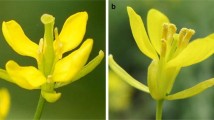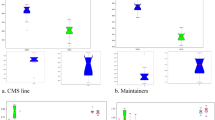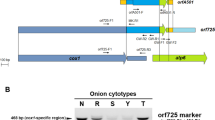Abstract
Key message
A new non-heading Chinese cabbage CMS line M119A was characterized and specific molecular markers were developed to classify different CMS types.
Abstract
One new non-heading Chinese cabbage (Brassica rapa L.) cytoplasmic male sterile (CMS) line M119A was obtained by interspecific crosses between the recently discovered hau CMS line of Brassica juncea and B. rapa. Furthermore, the line was characterized and compared with other five isonuclear-alloplasmic CMS lines. The M119A line produced six stamens without pollen and only two stamen fused together in fewer flowers. Tissue section indicated that anther abortion in M119A may have occurred during differentiation of the archesporial cells without pollen sac. All the six CMS lines were grouped into three types based on the presence of three PCR fragments of 825, 465 and 772 bp amplified with different mitochondrial genes specific primers. The 825-bp fragment was amplified both in 09-10A and H201A using the specific primer pair P-orf224-atp6, and showed 100 % identity with the mitochondrial gene of pol CMS. The 465-bp fragment was amplified in 30A and 105A using the primer pair P-orf138 and shared 100 % identity with the mitochondrial gene of ogu CMS. The 772-bp fragment was amplified in M119A and H203A using the primer pair P-orf288 and showed 100 % identity with the mitochondrial gene of hau CMS. Therefore, these markers could efficiently distinguish different types of isonuclear-alloplasmic CMS lines of non-heading Chinese cabbage, which were useful for improving the efficiency of cross-breeding and heterosis utilization in cruciferous vegetables.





Similar content being viewed by others
References
Bhat SR, Vijayan P, Ashutosh Dwivedi KK, Prakash S (2006) Diplotaxis erucoides-induced cytoplasmic male sterility in Brassica juncea is rescued by the Moricandia arvensis restorer: genetic and molecular analyses. Plant Breed 125:150–155
Bhat SR, Kumar P, Prakash S (2007) An improved cytoplasmic male sterile (Diplotaxis berthautii) Brassica juncea: identification of restorer and molecular characterization. Euphytica 159:145–152
Bonhomme S, Budar F, Lancelin D, Small I, Defrance MC, Pelletier G (1992) Sequence and transcript analysis of the Nco2.5 ogura-specific fragment correlation with cytoplasmic male sterility in Brassica cybrids. Mol Gen Genet 235:340–348
Chen QB, Hou XL, Wang JJ, Leng YQ, Jiang FL, Xue P (2006) Molecular identification of cytoplasmic male sterility line 101A of onion. Acta Bot Bor Occid Sin 26:30–33 (In Chinese)
Chen JM, Guan RZ, Chang SX, Du TQ, Zhang HS, **ng H (2011) Substoichiometrically different mitotypes coexist in mitochondrial genomes of Brassica napus L. PLoS One 6:E17662
Fang ZY, Sun PT, Liu YM, Yang LM, Wang XW, Zhuang M (2001) Investigation of different types of male sterility and application of dominant male sterility in cabbage. China Veg 1:6–10 (In Chinese)
Fu TD (1981) Production and research of rapeseed in the People’s Republic of China. Eucarpia Cruciferae Newsl 6:6–7
Fu TD (1995) Breeding and utilization of rapeseed hybrid. Hubei Science and Technology Press, Wuhan, pp 42–135 (In Chinese)
Guo JB, Chen BT, Liu BS (2007) Advances of plant mitochondrial proteome and cytoplasmic male sterility. Mol Plant Breed 5:111–117 (In Chinese)
Hama E, Takumi S, Ogihara Y (2004) Pistillody is caused by alteration to the class-B MADS-box gene expression pattern in alloplasmic wheats. Planta 218:712–720
Hanson MR, Bentolila S (2004) Interactions of mitochondrial and nuclear genes that affect male gametophyte development. Plant Cell 16:S154–S169
Heng SP, Wei C, **g B, Wan ZJ, Wen J, Yi B, Ma CZ, Tu JX, Fu TD, Shen JX (2014) Comparative analysis of mitochondrial genomes between the hau cytoplasmic male sterility (CMS) line and its iso-nuclear maintainer line in Brassica juncea to reveal the origin of the CMS-associated gene orf288. BMC Genom 15:322
Hu Q, Li YC, Mei DS, Fang XP, Hansen LN, Andersen SB (2004) Establishment and identification of cytoplasmic male sterility in Brassica napus by intergeneric somatic hybridization. Sci Agric Sin 37:333–338 (In Chinese)
Huang BQ, Chang L, Chen JG, **a YB (2001) Cytomorphology of anther development in Ogura CMS Brassica campestris var. purpuraria. J Hubei Univ Nat Sci 23:273–275 (In Chinses)
**g B, Heng SP, Tong D, Wan ZJ, Fu TD, Tu JX, Ma CZ, Yi B, Wen J, Shen JX (2012) A male sterility-associated cytotoxic protein orf288 in Brassica juncea causes aborted pollen development. J Exp Bot 63:1285–1295
Kaul MLH (1988) Male sterility in higher plants. Springer-Verlag, Berlin
Ke GL, Zhao ZY, Song YZ, Zhang LG, Zhao LM (1992) Breeding of alloplasmic male sterile line CMS3411-7 in Chinese cabbage. Acta Hort Sci 19:333–340 (In Chinese)
Kim S, Lim H, Park S, Cho KH, Sung SK, Oh DG, Kim KT (2007) Identification of a novel mitochondrial genome type and development of molecular makers for cytoplasm classification in radish (Raphanus sativus L.). Theor Appl Genet 115:1137–1145
L’Homme Y, Stahl RJ, Li XQ, Hameed A, Brown GG (1997) Brassica napus cytoplasmic male sterility is associated with expression of a mtDNA region containing a chimeric gene similar to the pol CMS-associated orf224 gene. Curr Genet 31:325–335
Landgren M, Zetterstrand M, Sundberg E, Glimelius K (1996) Alloplasmic male-sterile Brassica lines containing B. tournefortii mitochondria express an ORF 3 of the atp6 gene and a 32 kDa protein. Plant Mol Biol 32:879–890
Li DR (1980) Primary study of breeding on three-line hybrid in Brassica napus L. J Shanxi Agric Univ 1:26–29 (In Chinese)
Li JM, Yuan LP (2000) Hybrid rice: genetics, breeding, and seed production. Plant Breed Rev 17:150–158
Liang Y, Wang M, Zhao ZY (1994) Anther and pollen development in cytoplasm male sterile line of Chinese cabbage. J Northwest Agric Univ 22:19–23 (In Chinese)
Liu Z, Guan C, Zhao F, Chen S (2005) Inheritance and map** of a restorer gene for the rapeseed cytoplasmic male sterile line 681A. Plant Breed 124:5–8
Liu Z, Liu PW, Long FR, Hong DF, He QB, Yang GS (2012) Fine map** and candidate gene analysis of the nuclear restorer gene Rfp for pol CMS in rapeseed (Brassica napus L.). Theor Appl Genet 125:773–779
Ogura H (1968) Studies on the new male sterility in Japanese Radish, with special references to the utilization of this sterility towards the practical raising of hybrid seed. Mem Fac Agric Kagoshima Univ 6:39–78
Rawat DS, Anand IJ (1979) Male sterility in Indian mustard. Ind J Genet Plant Breed 39:412–414
Sanders PM, Bui AQ, Weterings K, McIntire KN, Hsu Y-C, Lee PY, Truong MT, Beals TP, Goldberg RB (1999) Anther developmental defects in Arabidopsis thaliana male-sterile mutants. Sex Plant Reprod 11:297–322
Schnable PS, Wise RP (1998) The molecular basis of cytoplasmic male sterility and fertility restoration. Trends Plant Sci 3:175–180
Shiga T, Baba S (1971) Cytoplasmic male sterility in rape plants (Brassica napus L). Jpn J Breed 21:16–17
Shiga T, Baba S (1973) Cytoplasmic male sterility in oilseed rape (Brassica napus L.), and its utilization to breeding. Jpn J Breed 23:187–197
Singh M, Brown GG (1991) Suppression of cytoplasmic male sterility by nuclear genes alters expression of a novel mitochondrial gene region. Plant Cell 3:1349–1362
Sodhi YS, Chandra A, Verma JK, Arumugam N, Mukhopadhyay A, Gupta V, Pental D, Pradhan AK (2006) A new cytoplasmic male sterility system for hybrid seed production in Indian oilseed mustard Brassica juncea. Theor Appl Genet 114:93–99
Tamura K, Dudley J, Nei M, Kumar S (2007) MEGA4 MolecularEvolutionary Genetics Analysis (MEGA) software version 4.0. Mol Biol Evol 24:1596–1599
Theissen G (2001) Development of floral organ identity: stories from the MADS house. Curr Opin Plant Biol 4:75–85
Thompson KR (1972) Cytoplasmic male sterility in oil-seed rape. Heredity 29:253–257
Tian FF, Xu YJ, Yuan L, Chen JJ (2004) The cytomorphology study of anther abortion in male-sterile lines of Hong cai-tai (Brassica rapa L.). J Wuhan Bot Res 22:270–271
Wan ZJ, Wan XJ, Fu TD (2006) Cytology study on the cytoplasmic male sterile line 6-102A in B. juncea. Chin J Oil Crop Sci 28:268–271 (In Chinese)
Wan ZJ, **g B, Tu JX, Ma CZ, Shen JX, Yi B, Wen J, Huang T, Wang XJ, Fu TD (2008) Genetic characterization of a new cytoplasmic male sterility system (hau) in Brassica juncea and its transfer to B. napus. Theor Appl Genet 116:355–362
Wan ZJ, Tan YB, Shi MH, Xu YJ, Aryamanesh N, Yan GJ (2013) Interspecific introgression of male sterility from tetraploid oilseed Brassica napus to diploid vegetable B. rapa through hybridisation and backcrossing. Crop Pasture Sci 64:652–659
Wan ZJ, Shi DY, Zou RC, Shi Z, Fu TD, Xu YJ (2014) Development and utilization of one new cytoplasmic male sterile line of Chinese leaf mustard (Brassica. juncea var. rugosa Bailey). Sci Hortic 165:211–217
Wang HM, Ketela T, Keller WA, Gleddie SC, Brown GG, Ketela T (1995) Genetic correlation of the orfl24/atp6 gene region with Polima CMS in Brassica somatic hybrids. Plant Mol Biol 27:801–807
Wang GH, Chen SY, Guan CY (2000) Study on the introgression of cytoplasmic male sterility in Brassica napus L. Crop Res 3:17–26 (In Chinese)
Wei BQ, Wei YT (1995) Study on the introgression of cytoplasmic male sterility in Brassica campestris spp. chinensis. China Veg 5:18–21 (In Chinese)
Wei WL, Wang HZ, Liu GH (2005) Molecular Identification of the sterile cytoplasm of NCa of a cytoplasmic male sterile line in rapeseed (Brassica napus L.). Sci Agric Sin 38:1965–1972 (In Chinese)
Yang JH, Zhang MF, Yu JQ, Wang T, Chen ZJ (2005) Molecular identification of cytoplasmic male sterility associated gene orf220 in leaf mustard (Brassica juncea var. multiceps Tsen et Lee). Acta Genet Sin 32:594–599
Yu FQ, Fu TD (1988) Cytological research on anther development of several varieties in Brassica napus L. Chin J Oil Crop Sci 4:23–24 (In Chinese)
Yu FQ, Fu TD (1990) Cytomorphological research on anther development of several male-sterile lines in Brassica napus L. J Wuhan Bot Res 8:209–210 (In Chinese)
Yuan M, Yang GS, Fu TD, Li Y (2003) Transcriptional control of orf224/atp6 by the pol CMS restorer Rfp gene in Brassica napus L. Acta Genet Sin 30:469–473
Zhao LM, Chen FG, Gong ZH, Zhao HF, Ke GL (2008) Cloning and molecular identification of gene associated with CMS RC7 in Chinese cabbage (Brassica napus L). Acta Bot Bor-Occid Sin 28:7–11 (In Chinese)
Zhao HX, Li ZJ, Hu SW, Sun GL, Chang JJ, Zhang ZH (2010) Identification of cytoplasm types in rapeseed (Brassica napus L.) accessions by a multiplex PCR assay. Theor Appl Genet 121:643–650
Zubko MK, Zubko E, Ryban AV, Adler K, Mock HP, Misera S, Gleba YY, Grimm B (2001) Extensive development and metabolic alteration in cybrids Nicotiana tabacum (+Hyoscyamus niger) are caused by complex nuclear-cytoplasmic incompatatibility. Plant J 5:627–639
Acknowledgments
This research was supported by National Science and Technology plan of China (2013BAD20B06), the Fundamental Research Funds for the Central Universities (2014PY060) and Special Fund for Agro-scientific Research in the Public Interest (201303014). The authors are grateful to Dr. Zaiyun Li, Hui Liu and Guijun Yan for critical reading of the manuscript and the anonymous reviewers for their constructive comments for revisions.
Conflict of interest
The authors declare that they have no conflict of interest.
Author information
Authors and Affiliations
Corresponding author
Additional information
Communicated by X. S. Zhang.
S. Heng, D. Shi and Z. Wan contributed equally to this work.
Accession numbers: sequence data from this article can be found in the GenBank/EMBL data libraries under the following accession numbers: atp6 (BAC98864), orf224 (AAA32982), atp9 (AEH43547), orf138 (CAA78273), except for orf288 which can be found in the supplemental data of reference **g et al. (2012).
Rights and permissions
About this article
Cite this article
Heng, S., Shi, D., Hu, Z. et al. Characterization and classification of one new cytoplasmic male sterility (CMS) line based on morphological, cytological and molecular markers in non-heading Chinese cabbage (Brassica rapa L.). Plant Cell Rep 34, 1529–1537 (2015). https://doi.org/10.1007/s00299-015-1804-y
Received:
Revised:
Accepted:
Published:
Issue Date:
DOI: https://doi.org/10.1007/s00299-015-1804-y




